Global Methane Retrieval, Monitoring, and Quantification in Hotspot Regions Based on AHSI/ZY-1 Satellite
Abstract
1. Introduction
2. Materials and Methods
2.1. Data Used
2.1.1. EMIT and AHSI/ZY-1 Data
2.1.2. GEOS-FP Reanalysis of Wind Speed Data
2.2. Incremental Methane Column Concentration Inversion Based on Matched Filter
2.3. Identifying Methane Plumes in ΔXCH4 Images
2.4. Accounting for Emission Flux Rates
2.5. Error Analysis
3. Results
3.1. Performance Analysis of Algorithm Inversion for Sea–Land Surface
3.2. Detection and Quantification of Global Methane Hotspot Plume Emissions Based on ZY-1 Satellite
4. Discussion
5. Conclusions
- (1)
- Optimizing the background covariance estimation method within the matched filter algorithm not only reduces the algorithm′s dependence on the quality of hyperspectral data but also effectively diminishes random noise in the background. This enhancement ensures that inversion speed is maintained while improving the robustness of the algorithm and the reliability of the inversion results.
- (2)
- This study demonstrates that, despite the lower spectral resolution of AHSI compared with other point source imagers, the optimized algorithm can detect emissions as low as 571 ± 95 kg/h. This detection threshold is comparable to the 500 kg/h threshold identified by previous research using the AHSI/GF-5, which has a higher spectral resolution. Moreover, the smaller number of spectral bands of AHSI/ZY-1 compared to AHSI/GF-5 results in significant advantages in inversion efficiency, suggesting its great potential for large-scale production of global methane plume products.
- (3)
- AHSI successfully detected and quantified methane emissions from the offshore Zaap-C oil and gas field in the Gulf of Mexico, a super-emission source. The detected emission rate of 78,847 ± 2719 kg/h is close to the combined emission rates of the other 15 plumes, highlighting the importance of addressing methane leaks not only from land-based facilities but also from offshore sources, which are often harder to detect due to their distance from populated areas.
Author Contributions
Funding
Institutional Review Board Statement
Informed Consent Statement
Data Availability Statement
Conflicts of Interest
Abbreviations
| GF-5 | Gaofen-5 Satellite |
| ZY-1 | Ziyuan-1 Satellite |
| AHSI | Advanced Hyperspectral Imager |
| MF | Matched Filter |
| IPCC | Intergovernmental Panel on Climate Change |
References
- Albós, A.C. Predictions of Our Future Global Climate: Models, Scenarios, and Projections. In Climate Change for Astronomers: Causes, Consequences, and Communication; IOP Astronomy: Bristol, UK, 2024; pp. 3-1–3-18. [Google Scholar]
- Sarfraz, M. Global Warming Cause and Impact on Climate Change. Int. J. Emerg. Knowl. Stud. 2024, 3, 198–204. Available online: https://ijeks.com/wp-content/uploads/2024/08/IJEKS-3-05-005.pdf (accessed on 16 February 2025).
- Lan, X.; Thoning, K.W.; Dlugokencky, E.J. Trends in Globally-Averaged CH4, N2O, and SF6 Determined from NOAA Global Monitoring Laboratory Measurements; Version 2025-02; NOAA Global Monitoring Laboratory: Boulder, CO, USA, 2025. [Google Scholar] [CrossRef]
- Xing, Y.; Wang, X. Impact of Agricultural Activities on Climate Change: A Review of Greenhouse Gas Emission Patterns in Field Crop Systems. Plants 2024, 13, 2285. [Google Scholar] [CrossRef]
- Saunois, M.; Martinez, A.; Poulter, B.; Zhang, Z.; Raymond, P.; Regnier, P.; Canadell, J.G.; Jackson, R.B.; Patra, P.K.; Bousquet, P.; et al. Global Methane Budget 2000–2020. Earth Syst. Sci. Data Discuss. 2024, preprint. [Google Scholar] [CrossRef]
- Vollrath, C. Methane Emissions from the Global Oil and Gas Industry: A Scoping Review to Characterize Research Trends, Knowledge Gaps, and Priorities. Master’s Thesis, University of Calgary, Calgary, AB, Canada, 2022. Available online: https://prism.ucalgary.ca/handle/1880/115218 (accessed on 16 February 2025).
- Rani, A.; Pundir, A.; Verma, M.; Joshi, S.; Verma, G.; Andjelković, S.; Babić, S.; Milenković, J.; Mitra, D. Methanotrophy: A Biological Method to Mitigate Global Methane Emission. Microbiol. Res. 2024, 15, 634–654. [Google Scholar] [CrossRef]
- Schuit, B.J.; Maasakkers, J.D.; Bijl, P.; Mahapatra, G.; Berg, A.-W.V.D.; Yaakoub, M.; Pandey, S.; Lorente, A.; Borsdorff, T.; Houweling, S.; et al. Automated detection and monitoring of methane super-emitters using satellite data. Atmos. Chem. Phys. Discuss. 2023, 23, 9071–9098. [Google Scholar] [CrossRef]
- Matoušková, E. Hyperspectral Imaging and Its Terrestrial Applications. Ph.D. Thesis, Czech Technical University, Prague, Czech, 2021. [Google Scholar]
- Wang, H.; Fan, X.; Jian, H.; Yan, F. Exploiting the Matched Filter to Improve the Detection of Methane Plumes with Sentinel-2 Data. Remote Sens. 2024, 16, 1023. [Google Scholar] [CrossRef]
- Irakulis-Loitxate, I.; Guanter, L.; Maasakkers, J.D.; Zavala-Araiza, D.; Aben, I. Satellites detect abatable super-emissions in one of the world’s largest methane hotspot regions. Environ. Sci. Technol. 2022, 56, 2143–2152. [Google Scholar] [CrossRef] [PubMed]
- Parker, R.; Boesch, H.; Cogan, A.; Fraser, A.; Feng, L.; Palmer, P.I.; Messerschmidt, J.; Deutscher, N.; Griffith, D.W.T.; Notholt, J.; et al. Methane observations from the Greenhouse Gases Observing SATellite: Comparison to ground-based TCCON data and model calculations. Geophys. Res. Lett. 2011, 38. [Google Scholar] [CrossRef]
- Suto, H.; Kataoka, F.; Kikuchi, N.; Knuteson, R.O.; Butz, A.; Haun, M.; Buijs, H.; Shiomi, K.; Imai, H.; Kuze, A. Thermal and near-infrared sensor for carbon observation Fourier-transform spectrometer-2 (TANSO-FTS-2) on the Greenhouse Gases Observing Satellite-2 (GOSAT-2) during its first year on orbit. Atmos. Meas. Tech. Discuss. 2020, 14, 2013–2039. [Google Scholar] [CrossRef]
- Lorente, A.; Borsdorff, T.; Butz, A.; Hasekamp, O.; de Brugh, J.A.; Schneider, A.; Wu, L.; Hase, F.; Kivi, R.; Wunch, D.; et al. Methane retrieved from TROPOMI: Improvement of the data product and validation of the first 2 years of measurements. Atmos. Meas. Tech. 2021, 14, 665–684. [Google Scholar] [CrossRef]
- Jacob, D.J.; Varon, D.J.; Cusworth, D.H.; Dennison, P.E.; Frankenberg, C.; Gautam, R.; Guanter, L.; Kelley, J.; McKeever, J.; Ott, L.E.; et al. Quantifying methane emissions from the global scale down to point sources using satellite observations of atmospheric methane. Atmos. Chem. Phys. 2022, 22, 9617–9646. [Google Scholar] [CrossRef]
- Varon, D.J.; McKeever, J.; Jervis, D.; Maasakkers, J.D.; Pandey, S.; Houweling, S.; Aben, I.; Scarpelli, T.; Jacob, D.J. Satellite discovery of anomalously large methane point sources from oil/gas production. Geophys. Res. Lett. 2019, 46, 13507–13516. [Google Scholar] [CrossRef]
- Guanter, L.; Irakulis-Loitxate, I.; Gorroño, J.; Sánchez-García, E.; Cusworth, D.H.; Varon, D.J.; Cogliati, S.; Colombo, R. Mapping methane point emissions with the PRISMA spaceborne imaging spectrometer. Remote Sens. Environ. 2021, 265, 112671. [Google Scholar] [CrossRef]
- Guanter, L.; Kaufmann, H.; Segl, K.; Foerster, S.; Rogass, C.; Chabrillat, S.; Kuester, T.; Hollstein, A.; Rossner, G.; Chlebek, C.; et al. The EnMAP Spaceborne Imaging Spectroscopy Mission for Earth Observation. Remote Sens. 2015, 7, 8830–8857. [Google Scholar] [CrossRef]
- Thorpe, A.K.; Green, R.O.; Thompson, D.R.; Brodrick, P.G.; Chapman, J.W.; Elder, C.D.; Irakulis-Loitxate, I.; Cusworth, D.H.; Ayasse, A.K.; Duren, R.M.; et al. Attribution of individual methane and carbon dioxide emission sources using EMIT observations from space. Sci. Adv. 2023, 9, eadh2391. [Google Scholar] [CrossRef]
- Hamburg, S.; Gautam, R.; Zavala-Araiza, D. MethaneSAT-A New Tool Purpose-Built to Measure Oil and Gas Methane Emissions from Space. In Proceedings of the Abu Dhabi International Petroleum Exhibition and Conference, Abu Dhabi, United Arab Emirates, 31 October–3 November 2022; p. D011S007R002. [Google Scholar] [CrossRef]
- Planet Labs PBC. Planet Hyperspectral. 2024. Available online: https://www.planet.com/products/hyperspectral/ (accessed on 13 April 2025).
- Hu, K.; Feng, X.; Zhang, Q.; Shao, P.; Liu, Z.; Xu, Y.; Wang, S.; Wang, Y.; Wang, H.; Di, L.; et al. Review of Satellite Remote Sensing of Carbon Dioxide Inversion and Assimilation. Remote Sens. 2024, 16, 3394. [Google Scholar] [CrossRef]
- He, Z.; Gao, L.; Liang, M.; Zeng, Z.-C. A survey of methane point source emissions from coal mines in Shanxi province of China using AHSI on board Gaofen-5B. Atmos. Meas. Tech. 2024, 17, 2937–2956. [Google Scholar] [CrossRef]
- Sherw Chen, L.; Sui, X.; Liu, R.; Chen, H.; Li, Y.; Zhang, X.; Chen, H. Mapping Alteration Minerals Using ZY-1 02D Hyperspectral Remote Sensing Data in Coalbed Methane Enrichment Areas. Remote Sens. 2023, 15, 3590. [Google Scholar] [CrossRef]
- Foote, M.D.; Dennison, P.E.; Thorpe, A.K.; Thompson, D.R.; Jongaramrungruang, S.; Frankenberg, C.; Joshi, S.C. Fast and accurate retrieval of methane concentration from imaging spectrometer data using sparsity prior. IEEE Trans. Geosci. Remote Sens. 2020, 58, 6480–6492. [Google Scholar] [CrossRef]
- Pei, Z.; Han, G.; Mao, H.; Chen, C.; Shi, T.; Yang, K.; Ma, X.; Gong, W. Improving quantification of methane point source emissions from imaging spectroscopy. Remote Sens. Environ. 2023, 295, 113652. [Google Scholar] [CrossRef]
- Sherwin, E.D.; Rutherford, J.S.; Chen, Y.; Aminfard, S.; Kort, E.A.; Jackson, R.B.; Brandt, A.R. Single-blind validation of space-based point-source detection and quantification of onshore methane emissions. Sci. Rep. 2023, 13, 3836. [Google Scholar] [CrossRef] [PubMed]
- Sherwin, E.D.; El Abbadi, S.H.; Burdeau, P.M.; Zhang, Z.; Chen, Z.; Rutherford, J.S.; Chen, Y.; Brandt, A.R. Single-blind test of nine methane-sensing satellite systems from three continents. Atmos. Meas. Tech. 2024, 17, 765–782. [Google Scholar] [CrossRef]
- Dowd, E.; Manning, A.J.; Orth-Lashley, B.; Girard, M.; France, J.; Fisher, R.E.; Lowry, D.; Lanoisellé, M.; Pitt, J.R.; Stanley, K.M.; et al. First validation of high-resolution satellite-derived methane emissions from an active gas leak in the UK. Atmos. Meas. Tech. 2024, 17, 1599–1615. [Google Scholar] [CrossRef]
- Karacan, C.Ö.; Irakulis-Loitxate, I.; Field, R.A.; Warwick, P.D. Temporal and spatial comparison of coal mine ventilation methane emissions and mitigation quantified using PRISMA satellite data and on-site measurements. Sci. Total Environ. 2025, 975, 179268. [Google Scholar] [CrossRef]
- Li, F.; Sun, S.W.; Zhang, Y.G.; Feng, C.X.; Chen, C.H.; Mao, H.Q.; Liu, Y.N. Mapping methane super-emitters in China and United States with GF5-02 hyperspectral imaging spectrometer. Natl. Remote Sens. Bull. 2024, 28, 1986–2001. [Google Scholar] [CrossRef]
- Irakulis-Loitxate, I.; Guanter, L.; Liu, Y.-N.; Varon, D.J.; Maasakkers, J.D.; Zhang, Y.; Chulakadabba, A.; Wofsy, S.C.; Thorpe, A.K.; Duren, R.M.; et al. Satellite-based survey of extreme methane emissions in the Permian basin. Sci. Adv. 2021, 7, eabf4507. [Google Scholar] [CrossRef] [PubMed]
- Han, G.; Pei, Z.; Shi, T.; Mao, H.; Li, S.; Mao, F.; Ma, X.; Zhang, X.; Gong, W. Unveiling unprecedented methane hotspots in China’s leading coal production hub: A satellite mapping revelation. Geophys. Res. Lett. 2024, 51, e2024GL109065. [Google Scholar] [CrossRef]
- Green, R.O.; Mahowald, N.; Ung, C.; Thompson, D.R.; Bator, L.; Bennet, M.; Bernas, M.; Blackway, N.; Bradley, C.; Cha, J.; et al. The Earth surface mineral dust source investigation: An Earth science imaging spectroscopy mission. In Proceedings of the 2020 IEEE Aerospace Conference, Big Sky, MT, USA, 7–14 March 2020; IEEE: Piscataway, NJ, USA, 2020; pp. 1–15. [Google Scholar] [CrossRef]
- NASA Earth Science. Meet EMIT: NASA’s Newest Imaging Spectrometer. NASA Earth Data. 2022. Available online: https://www.earthdata.nasa.gov/news/feature-articles/meet-emit-newest-imaging-spectrometer (accessed on 21 April 2025).
- SAS Clouds. ZY-102D Remote Sensing Satellite. Available online: https://www.sasclouds.com/chinese/satellite/chinese/zy102d (accessed on 21 April 2025).
- Arnold, N.; Putman, W.; Freitas, S.; Takacs, L.; Rabenhorst, S. Impacts of New Atmospheric Physics in the Updated GEOS FP System (Version 5.25); NASA Global Modeling and Assimilation Office Reserch Brief: Greenbelt, MD, USA, 2020; Volume 9. [Google Scholar]
- Thorpe, A.K.; Frankenberg, C.; Roberts, D.A. Retrieval techniques for airborne imaging of methane concentrations using high spatial and moderate spectral resolution: Application to AVIRIS. Atmos. Meas. Tech. 2014, 7, 491–506. [Google Scholar] [CrossRef]
- Thorpe, A.; Frankenberg, C.; Aubrey, A.; Roberts, D.; Nottrott, A.; Rahn, T.; Sauer, J.; Dubey, M.; Costigan, K.; Arata, C.; et al. Mapping methane concentrations from a controlled release experiment using the next generation airborne visible/infrared imaging spectrometer (AVIRIS-NG). Remote Sens. Environ. 2016, 179, 104–115. [Google Scholar] [CrossRef]
- Thompson, D.R.; Thorpe, A.K.; Frankenberg, C.; Green, R.O.; Duren, R.; Guanter, L.; Hollstein, A.; Middleton, E.; Ong, L.; Ungar, S. Space-based remote imaging spectroscopy of the Aliso Canyon CH4 superemitter. Geophys. Res. Lett. 2016, 43, 6571–6578. [Google Scholar] [CrossRef]
- Foote, M.D.; Dennison, P.E.; Sullivan, P.R.; O’Neill, K.B.; Thorpe, A.K.; Thompson, D.R.; Cusworth, D.H.; Duren, R.; Joshi, S.C. Impact of scene-specific enhancement spectra on matched filter greenhouse gas retrievals from imaging spectroscopy. Remote Sens. Environ. 2021, 264, 112574. [Google Scholar] [CrossRef]
- Thompson, D.R.; Leifer, I.; Bovensmann, H.; Eastwood, M.; Fladeland, M.; Frankenberg, C.; Gerilowski, K.; Green, R.O.; Kratwurst, S.; Krings, T.; et al. Real-time remote detection and measurement for airborne imaging spectroscopy: A case study with methane. Atmos. Meas. Tech. 2015, 8, 4383–4397. [Google Scholar] [CrossRef]
- Ayasse, A.K.; Dennison, P.E.; Foote, M.; Thorpe, A.K.; Joshi, S.; Green, R.O.; Duren, R.M.; Thompson, D.R.; Roberts, D.A. Methane Mapping with Future Satellite Imaging Spectrometers. Remote Sens. 2019, 11, 3054. [Google Scholar] [CrossRef]
- El Akkraoui, A.; Privé, N.C.; Errico, R.M.; Todling, R. The GMAO Hybrid 4D-EnVar Observing System Simulation Experiment Framework. Mon. Weather Rev. 2023, 151, 1717–1734. [Google Scholar] [CrossRef]
- Zhang, S.; Ma, J.; Zhang, X.; Guo, C. Atmospheric remote sensing for anthropogenic methane emissions: Applications and research opportunities. Sci. Total Environ. 2023, 893, 164701. [Google Scholar] [CrossRef]
- Cusworth, D.H.; Duren, R.M.; Yadav, V.; Thorpe, A.K.; Verhulst, K.; Sander, S.; Hopkins, F.; Rafiq, T.; Miller, C.E. Synthesis of methane observations across scales: Strategies for deploying a multitiered observing network. Geophys. Res. Lett. 2020, 47, e2020GL087869. [Google Scholar] [CrossRef]
- Varon, D.J.; Jervis, D.; McKeever, J.; Spence, I.; Gains, D.; Jacob, D.J. High-frequency monitoring of anomalous methane point sources with multispectral Sentinel-2 satellite observations. Atmos. Meas. Tech. 2021, 14, 2771–2785. [Google Scholar] [CrossRef]
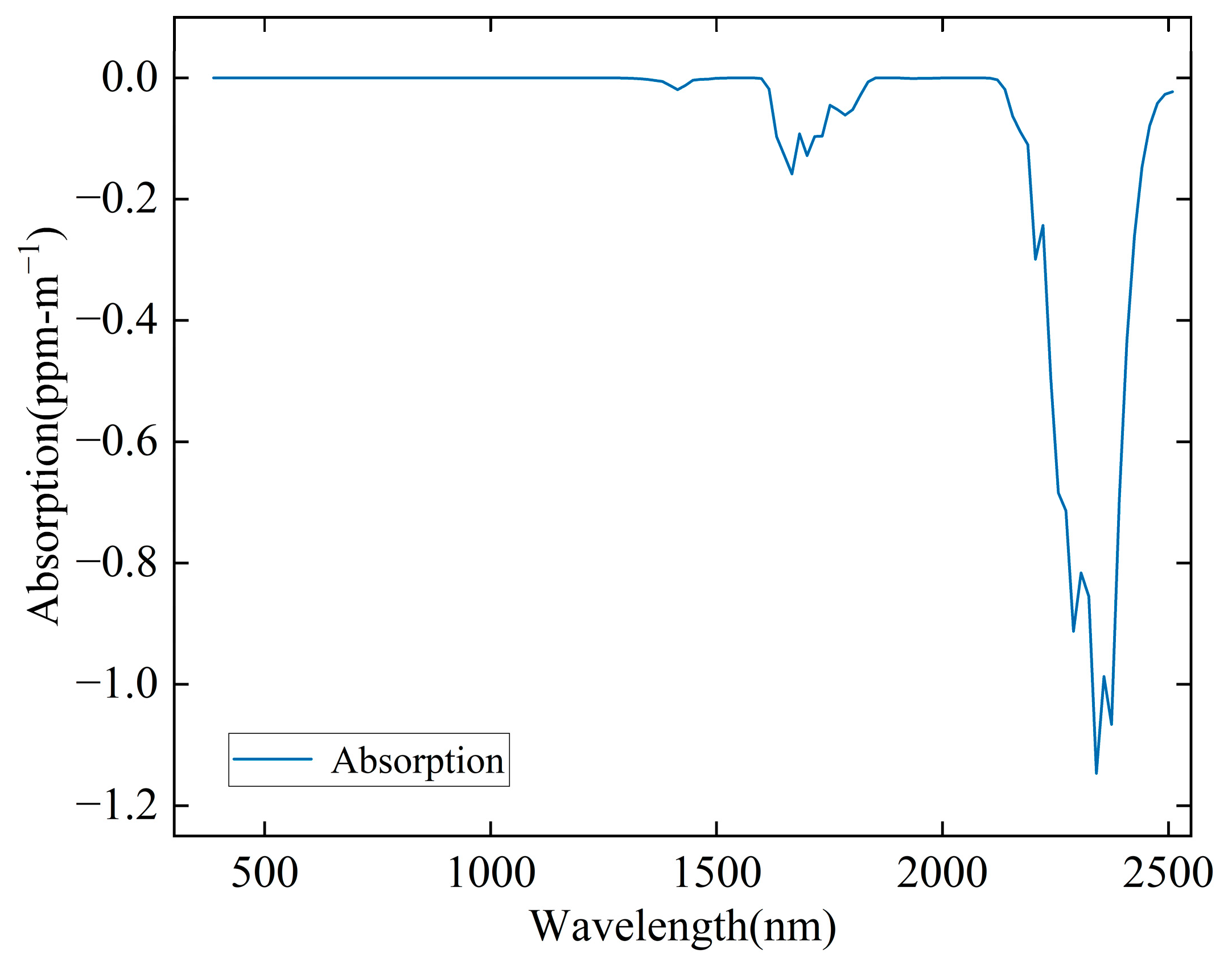

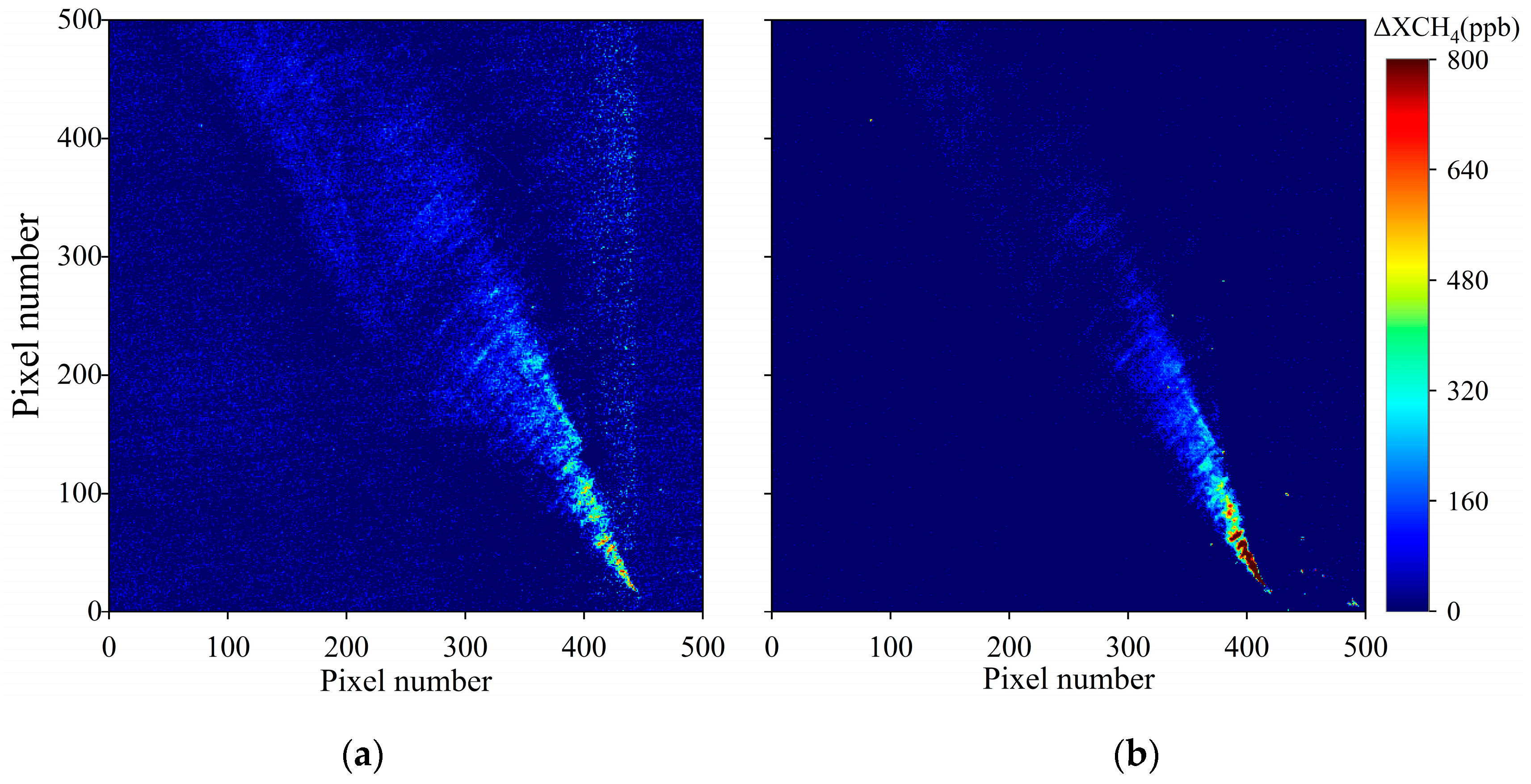
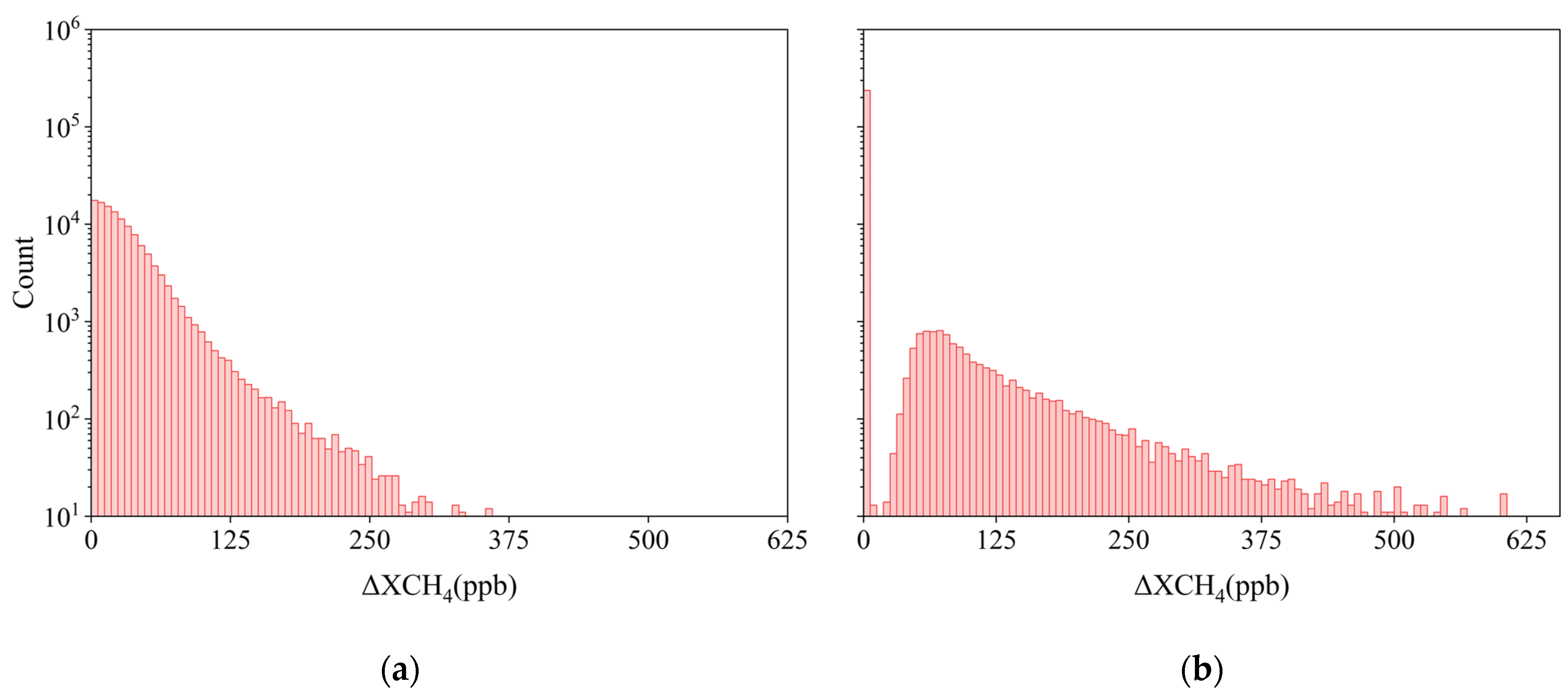


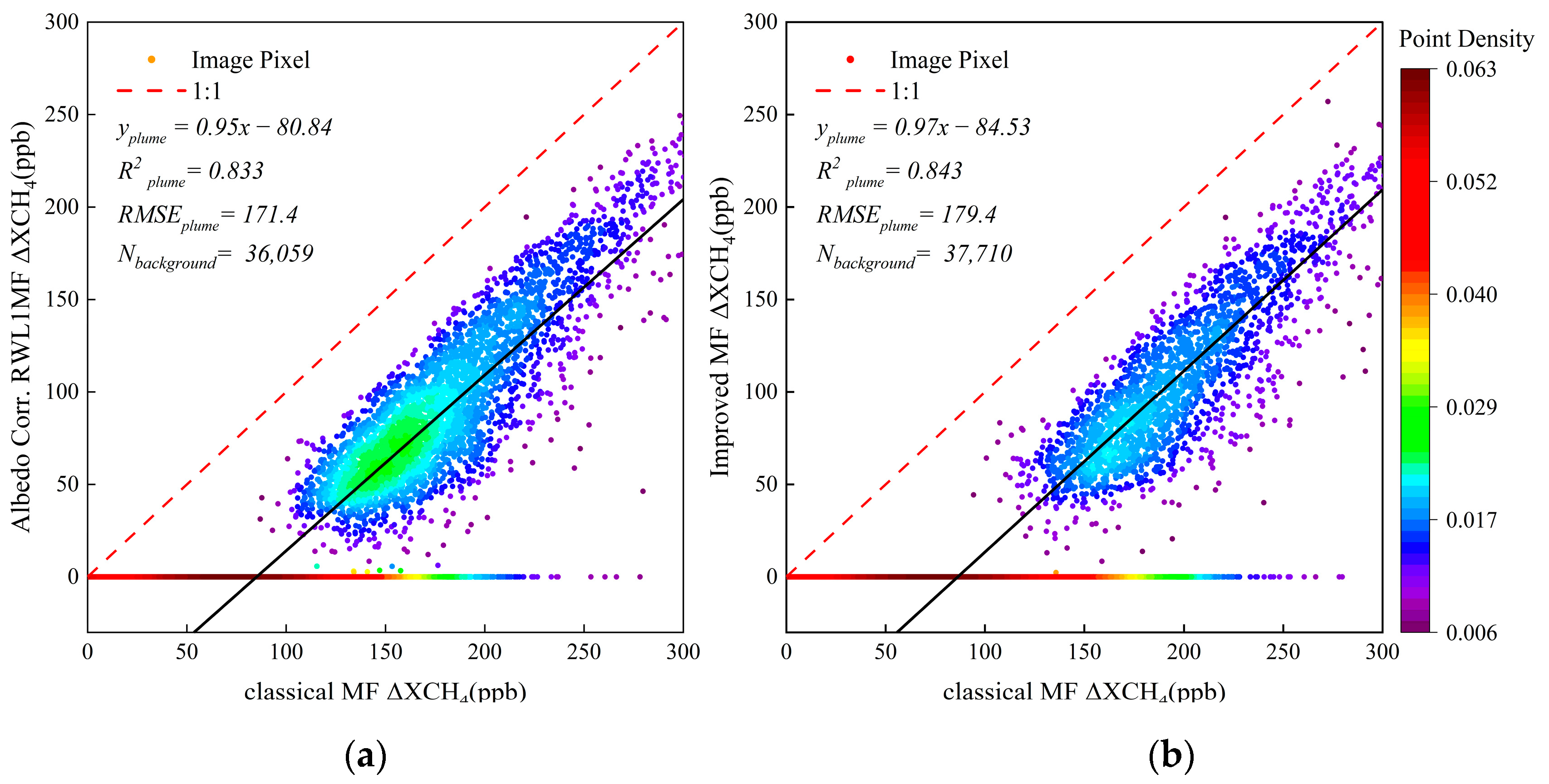
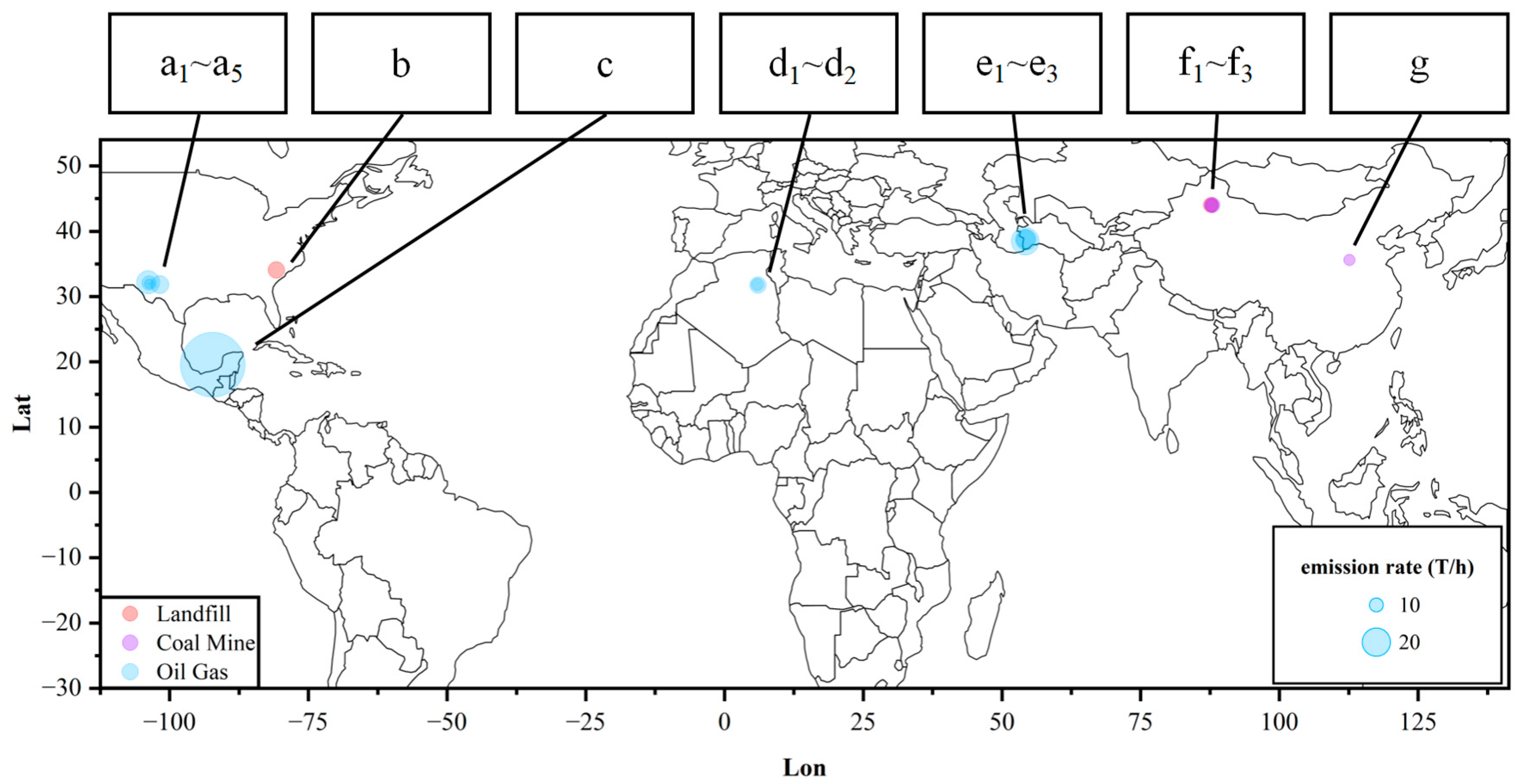
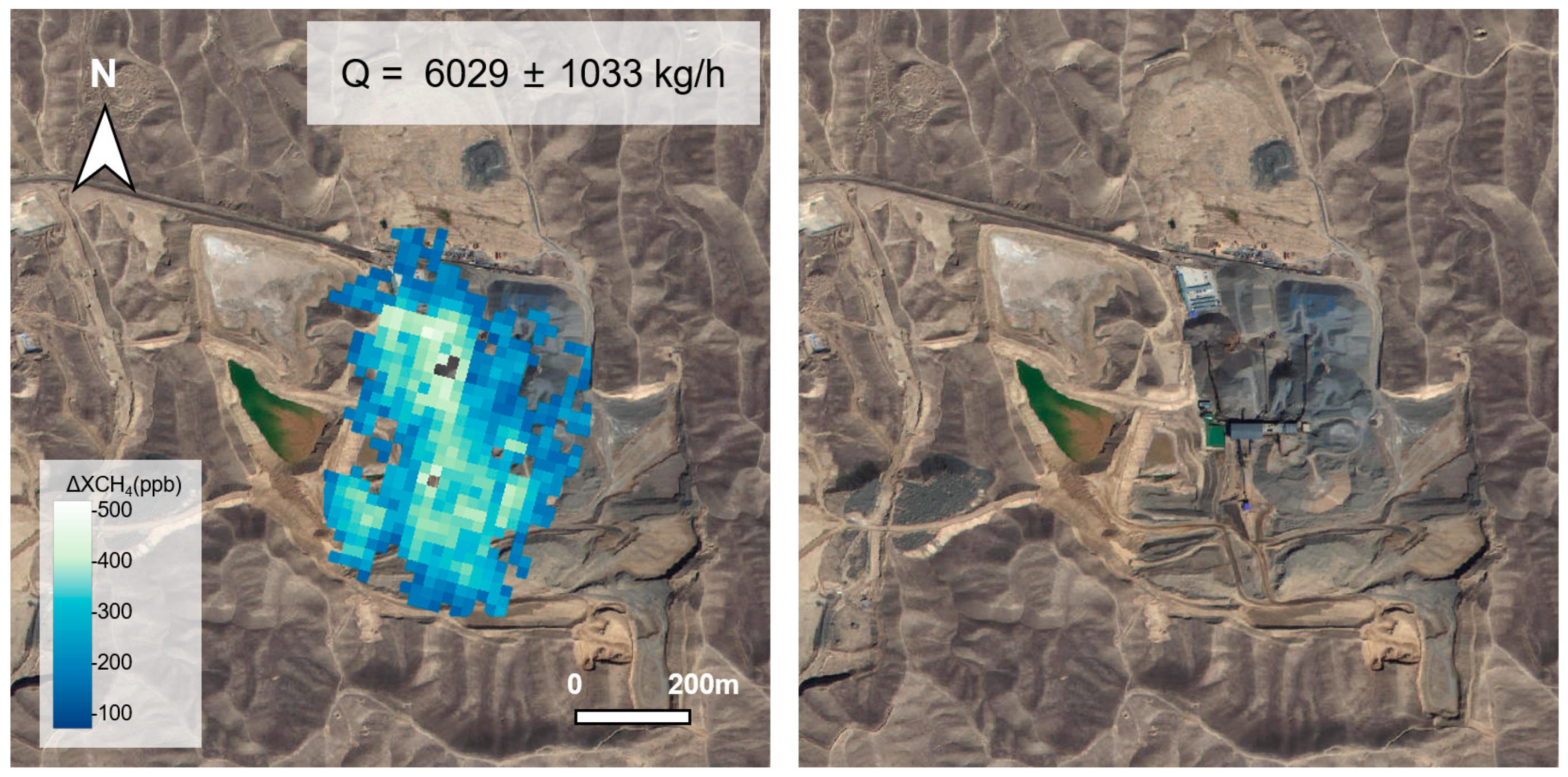
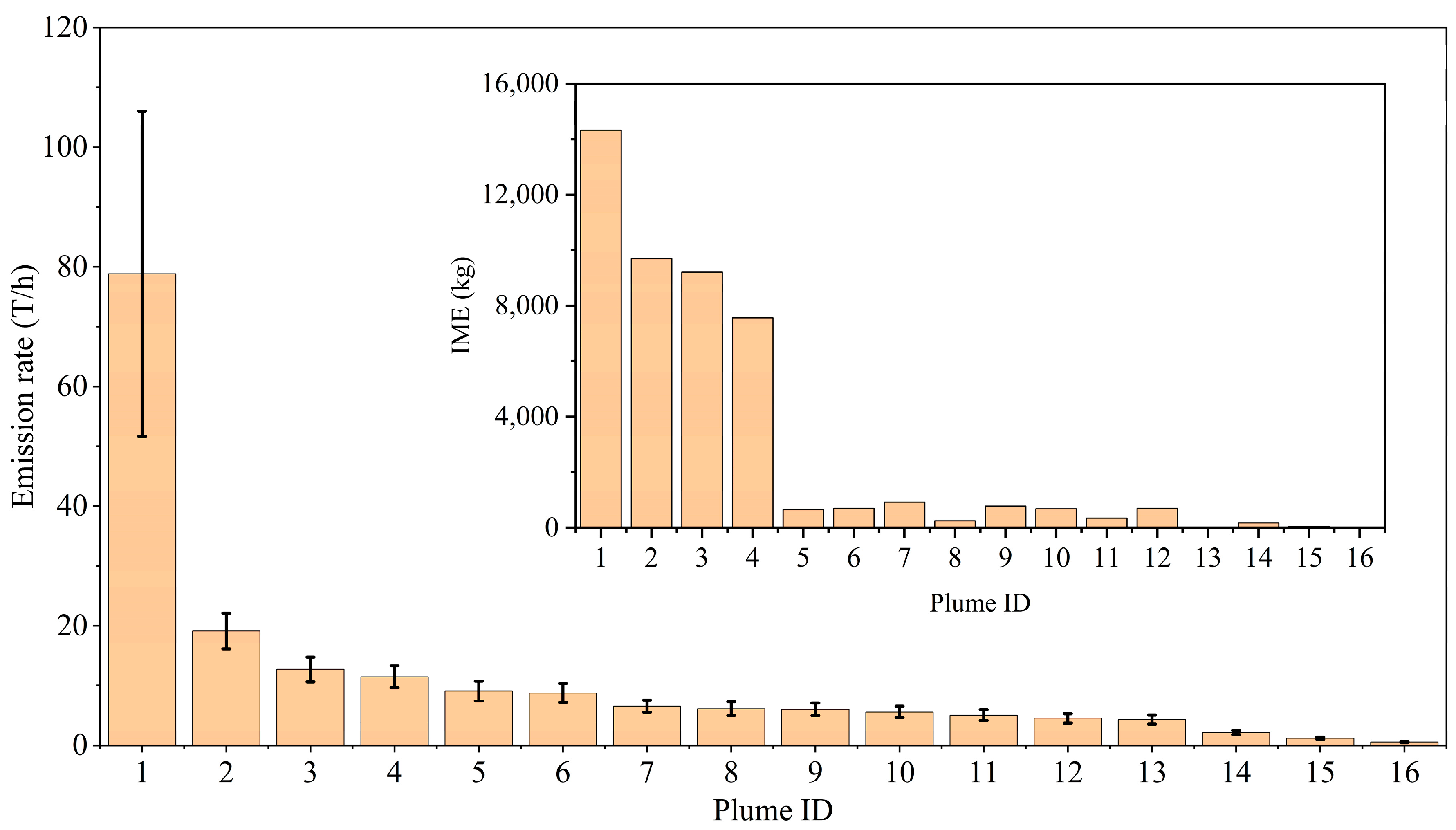
| Satellite /Sensor | Launch (Year) | Country | Methane Window Range (nm) | Spectral Resolution (nm) | Spatial Resolution | Reference |
|---|---|---|---|---|---|---|
| GOSAT/FTS | 2009 | Japan | 1560–1720 | 0.05 | 10.5 km | [12] |
| GOSAT-2/FTS-2 | 2018 | Japan | 1560–1690 | 0.05 | 9.7 km | [13] |
| GHGSat/WAF-P | 2016, 2020–2023 | Canada | 1600–1700 | 0.3 | 25 m | [16] |
| Sentiel-5P/TROPOMI | 2017 | Netherlands | 2305–2385 | 0.25 | 7 km × 5.5 km | [14,15] |
| GF-5/AHSI | 2018 | China | 1600–1700, 2200–2500 | 5–10 | 30 m | [22] |
| ZY-1/AHSI | 2019 | China | 1600–1700, 2200–2500 | 10–20 | 30 m | [23] |
| PRISMA/HYC | 2019 | Italy | 1600–1700, 2200–2510 | 10 | 30 m | [17] |
| EnMAP/HSI | 2022 | Germany | 1600–1700, 2200–2510 | 6.5–10 | 30 m | [18] |
| ISS/EMIT | 2022 | United States | 1600–1700, 2200–2493 | 7.5 | 60 m | [19] |
| MethaneSAT | 2024 | United States | 1598–1683 | 0.25 | 100 m × 400 m | [20] |
| Tanager-1 | 2024 | United States | 1600–1700, 2200–2500 | 5 | 30 m | [21,22] |
| Sensor/Satellite | Date | Image ID |
|---|---|---|
| EMIT/ISS | 21 April 2024 | EMIT_L1B_RAD_001_20240421T184222_2411212_043 |
| EMIT/ISS | 5 February 2023 | EMIT_L1B_RAD_001_20230205T171255_2303612_007 |
| AHSI/ZY1F | 16 April 2024 | ZY1F_AHSI_W92.32_N19.70_20240416_012087_L1A0000712903 |
| AHSI/ZY1F | 6 July 2023 | ZY1F_AHSI_E87.60_N44.12_20230707_008006_L1A0000479173 |
| AHSI/ZY1E | 26 October 2020 | ZY1E_AHSI_E54.02_N38.83_20201026_005889_L1A0000192157 |
| AHSI/ZY1E | 19 February 2021 | ZY1E_AHSI_E54.39_N38.38_20210219_007553_L1A0000244210 |
| AHSI/ZY1E | 6 December 2023 | ZY1E_AHSI_E112.40_N35.73_20231206_022179_L1A0000687604 |
| AHSI/ZY1E | 27 November 2023 | ZY1E_AHSI_E6.09_N31.66_20231127_022057_L1A0000683681 |
| AHSI/ZY1F | 29 April 2024 | ZY1F_AHSI_W102.02_N31.73_20240429_012274_L1A0000724023 |
| AHSI/ZY1F | 19 May 2024 | ZY1F_AHSI_W104.17_N32.17_20240519_012561_L1A0000739948 |
| AHSI/ZY1E | 17 January 2024 | ZY1E_AHSI_W103.75_N32.17_20240117_022795_L1A0000708354 |
| AHSI/ZY1F | 31 August 2023 | ZY1F_AHSI_W80.86_N33.95_20240414_012058_L1A0000710869 |
| Plume ID | Emission Source Type | Emission Rate (kg/h) | Date | Latitude | Longitude |
|---|---|---|---|---|---|
| a1 | Oil and Gas | 4535 ± 791 | 29 April 2024 | 31°51′31.7″ N | 101°45′52.2″ W |
| a2 | Oil and Gas | 9086 ± 1659 | 19 May 2024 | 32°12′03.9″ N | 103°54′53.6″ W |
| a3 | Oil and Gas | 571 ± 95 | 17 January 2024 | 31°57′09.7″ N | 103°40′14.4″ W |
| a4 | Oil and Gas | 2154 ± 358 | 17 January 2024 | 31°57′15.6″ N | 103°40′41.2″ W |
| a5 | Oil and Gas | 1170 ± 195 | 17 January 2024 | 32°04′13.1″ N | 103°43′39.5″ W |
| b | Landfill | 6543 ± 1018 | 14 April 2024 | 34°06′26.2″ N | 80°46′17.8″ W |
| c | Oil and Gas | 78,847 ± 2719 | 16 April 2024 | 19°34′1.61″ N | 92°14′15.25″ W |
| d1 | Oil and Gas | 8754 ± 1586 | 27 November 2023 | 31°46′42.79″ N | 5°59′42.51″ E |
| d2 | Oil and Gas | 5072 ± 919 | 27 November 2023 | 31°50′7.60″ N | 5°56′36.74″ E |
| e1 | Oil and Gas | 11,453 ± 1845 | 26 October 2020 | 38°51′09.7″ N | 54°14′12.8″ E |
| e2 | Oil and Gas | 12,698 ± 2046 | 26 October 2020 | 38°41′21.9″ N | 54°18′53.7″ E |
| e3 | Oil and Gas | 19,142 ± 2977 | 19 February 2021 | 38°29′37.7″ N | 54°11′47.0″ E |
| f1 | Landfill | 5588 ± 958 | 6 July 2023 | 44°2′20.84″ N | 87°51′59.79″ E |
| f2 | Coal Mines | 6029 ± 1033 | 6 July 2023 | 44°0′39.99″ N | 87°50′11.32″ E |
| f3 | Coal Mines | 4298 ± 762 | 31 August 2023 | 44°0′39.99″ N | 87°50′11.32″ E |
| g | Coal Mines | 6146 ± 1126 | 6 December 2023 | 35°37′7.65″ N | 112°36′34.14″ E |
Disclaimer/Publisher’s Note: The statements, opinions and data contained in all publications are solely those of the individual author(s) and contributor(s) and not of MDPI and/or the editor(s). MDPI and/or the editor(s) disclaim responsibility for any injury to people or property resulting from any ideas, methods, instructions or products referred to in the content. |
© 2025 by the authors. Licensee MDPI, Basel, Switzerland. This article is an open access article distributed under the terms and conditions of the Creative Commons Attribution (CC BY) license (https://creativecommons.org/licenses/by/4.0/).
Share and Cite
Lu, T.; Li, Z.; Fan, C.; He, Z.; Jiang, X.; Zhang, Y.; Gao, Y.; Xuan, Y.; de Leeuw, G. Global Methane Retrieval, Monitoring, and Quantification in Hotspot Regions Based on AHSI/ZY-1 Satellite. Atmosphere 2025, 16, 510. https://doi.org/10.3390/atmos16050510
Lu T, Li Z, Fan C, He Z, Jiang X, Zhang Y, Gao Y, Xuan Y, de Leeuw G. Global Methane Retrieval, Monitoring, and Quantification in Hotspot Regions Based on AHSI/ZY-1 Satellite. Atmosphere. 2025; 16(5):510. https://doi.org/10.3390/atmos16050510
Chicago/Turabian StyleLu, Tong, Zhengqiang Li, Cheng Fan, Zhuo He, Xinran Jiang, Ying Zhang, Yuanyuan Gao, Yundong Xuan, and Gerrit de Leeuw. 2025. "Global Methane Retrieval, Monitoring, and Quantification in Hotspot Regions Based on AHSI/ZY-1 Satellite" Atmosphere 16, no. 5: 510. https://doi.org/10.3390/atmos16050510
APA StyleLu, T., Li, Z., Fan, C., He, Z., Jiang, X., Zhang, Y., Gao, Y., Xuan, Y., & de Leeuw, G. (2025). Global Methane Retrieval, Monitoring, and Quantification in Hotspot Regions Based on AHSI/ZY-1 Satellite. Atmosphere, 16(5), 510. https://doi.org/10.3390/atmos16050510









